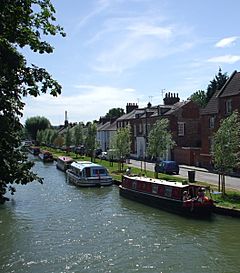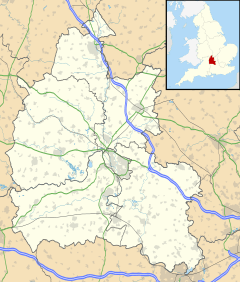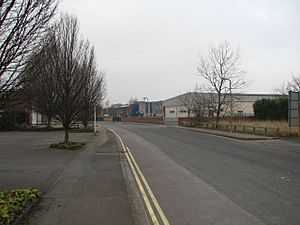Osney facts for kids
Quick facts for kids Osney |
|
|---|---|
 East Street, Osney Island viewed from Osney Bridge |
|
| OS grid reference | SP502060 |
| Civil parish |
|
| District | |
| Shire county | |
| Region | |
| Country | England |
| Sovereign state | United Kingdom |
| Post town | Oxford |
| Postcode district | OX1 |
| Dialling code | 01865 |
| Police | Thames Valley |
| Fire | Oxfordshire |
| Ambulance | South Central |
| EU Parliament | South East England |
| UK Parliament |
|
| Website | Oxford City Council |
Osney or Osney Island is a small area in the west of Oxford, England. It's a community often called Osney Town. This area sits on an island near the main train station. It's surrounded by parts of the River Thames, a channel called Osney Ditch, and other small waterways.
Long ago, the name Osney referred to a bigger island. This larger island included Oxford Castle and New Osney. Important places like Osney Abbey and Osney Mill were built there centuries ago. Osney even appears in The Miller's Tale by Geoffrey Chaucer in The Canterbury Tales.
Contents
Understanding Osney's History
The name "Osney" comes from Old English. It likely means "Osa's Island" or "island in the Ouse." "Ouse" is an old word for a large river. For a long time, Osney was the island between two streams of the River Thames. These were the Castle Mill Stream and what is now the main river channel. To the north, the Sheepwash Channel separates Osney from Fiddler's Island.
Ancient Buildings and Changes
Osney Abbey was a large monastery founded here in 1129. Later, Rewley Abbey was built in the northern part of the island in 1280. Osney Mill was a mill started by Osney Abbey on the west side. After the monasteries were closed in 1538, their lands went to Christ Church college. The island was part of St. Thomas's parish.
In 1790, the mill stream that fed Osney Mill became the main river route. This happened when Osney Lock was opened.
How Osney Grew with Railways
Before the 1800s, only the eastern side of the island was developed. But in the 1800s, Osney changed a lot. The Great Western Railway built its train line across the island in 1850. They built new bridges, including one across the Thames. A new train station opened on the island two years later.
In 1851, another railway company, the Buckinghamshire Railway, also built a line. It led to their Rewley Road station next to the GWR station. To house all the new railway workers, Osney Town was created in 1851. George P. Hester designed this new area on an island he leased from Christ Church.
Later, in the 1860s, an area called New Osney grew. It was built around Mill Street, south of Botley Road. The Cripley estate, north of Botley Road, was developed in 1878. Osney Cemetery also opened in the south of the island in 1848.
Osney Today
Today, when people say "Osney," they usually mean Osney Town. Most of the homes here are 19th-century terraced cottages. These were built on Hester's original street plan. A few newer and larger houses also exist.
The island has two public houses, which are like local pubs: The Punter and The Holly Bush. There is also the West Oxford Democrats Club. Osney is part of a local government area called Jericho and Osney.
New Osney and Other Areas
The name Osney is not used for the original large island anymore. The eastern part of that island is now called St Thomas. However, the name "Osney" still appears in places like New Osney, Osney Lane, Osney Cemetery, Osney Mill, and Osney Marina. Osney Bridge carries the Botley Road (which is the A420) west from the historic Osney island. Osney Lock was built in the river in 1790.
Osney Mead: A Business Area
Starting in 1961, an industrial estate was developed. It was named Osney Mead in 1966. This area was built on former meadowland between Osney and Bulstake Stream. It was meant to move businesses that were in inconvenient locations.
Many organizations are based there today. These include publishers like Alden Mowbray and Holywell Press. The Oxford Community Church also has a building there. The Bodleian Libraries and the Department of Engineering Science, University of Oxford have buildings at the southeastern end of Osney Mead.
Newspaper House was designed by Arup Associates and built between 1970 and 1972. It has open-plan offices. This building is the main office for Newsquest in Oxfordshire. Newsquest publishes local newspapers like the weekly The Oxford Times and the daily Oxford Mail.



